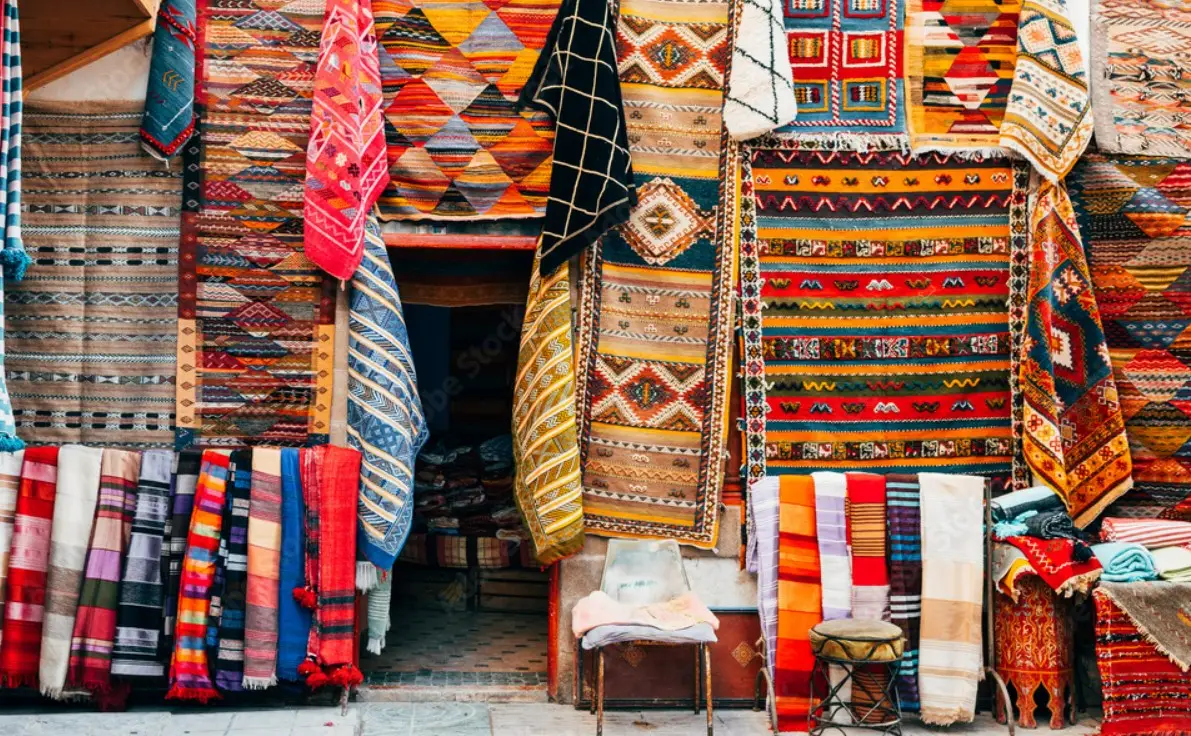Overview of Mytique Moroccan Rugs
Step into the captivating world of Moroccan handmade carpets / rugs, where centuries-old traditions and cultural heritage intertwine to create masterpieces of artistry and symbolism. In this comprehensive guide, we invite you to embark on a journey through the diverse landscape of Moroccan tribal rugs, discovering the unique styles, techniques, and cultural significance that make them a perfect choice for enriching your home decor.
Beni Ourain Rugs: The Timeless Elegance of Woolen Treasures
Dive into the luxurious world of Beni Ourain rugs, crafted by the Berber tribes of the Atlas Mountains. These handwoven masterpieces feature distinctive geometric patterns and plush wool fibers, offering warmth, comfort, and sophistication to any space.
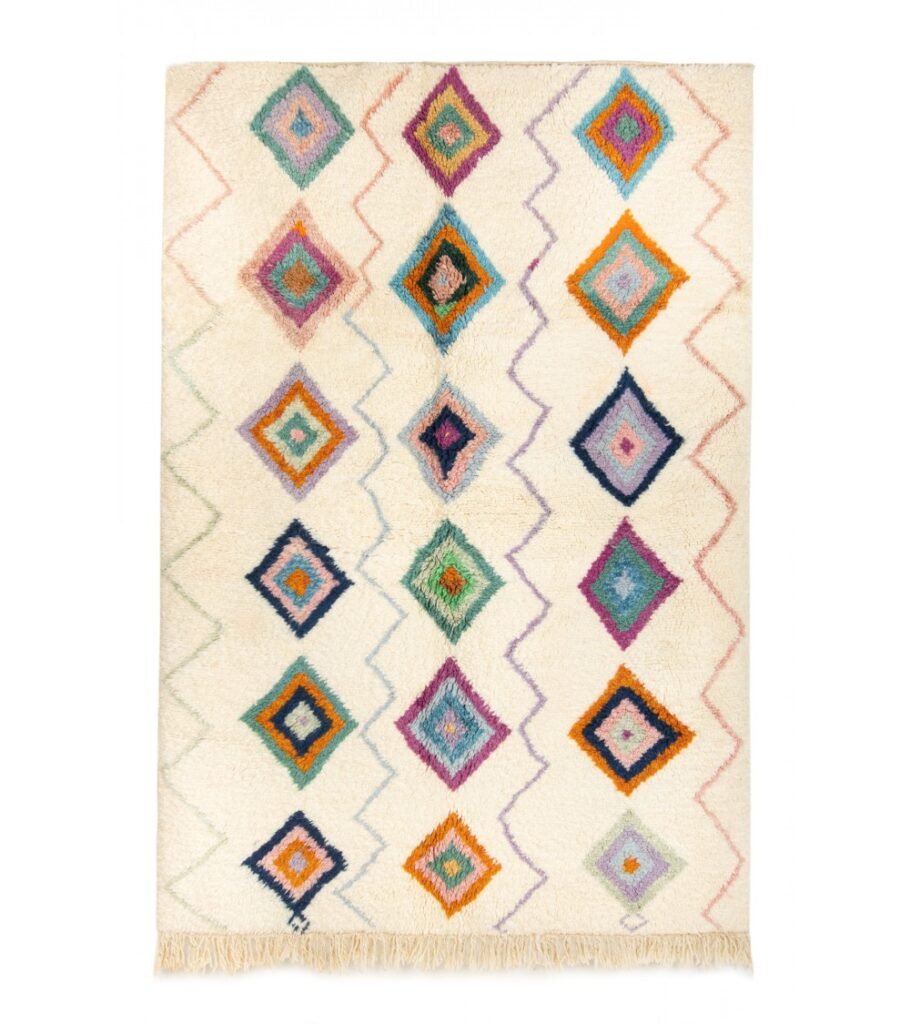
SAMPLE : BENI OURAIN RUG
History
Beni Ourain rugs have a rich history dating back centuries to the Beni Ourain tribe of the Atlas Mountains in Morocco. Traditionally, these rugs were crafted by Berber women for personal use, serving as practical floor coverings and warm bedding during harsh winters. Over time, their exquisite craftsmanship and minimalist designs gained recognition beyond the Berber community, attracting attention from interior designers and collectors worldwide.
Signification
Beni Ourain rugs hold significant cultural and symbolic meaning for the Berber tribes of Morocco. They are often woven with intricate geometric patterns and symbols that convey tribal identity, family lineage, and spiritual beliefs. Each rug tells a unique story and serves as a form of artistic expression for the weaver, reflecting the rhythms of daily life, nature, and the surrounding landscape.
Symbols & Colors Used
The patterns and symbols found in Beni Ourain rugs are deeply symbolic, with each motif holding its own meaning. Common symbols include diamonds, chevrons, and asymmetrical lines, representing elements of nature, fertility, and protection. The colors used in Beni Ourain rugs are typically neutral tones such as ivory, black, and brown, which symbolize purity, strength, and resilience.
Raw Materials
Beni Ourain rugs are crafted from high-quality wool sourced from the sheep that graze the rugged terrain of the Moroccan highlands. The wool is prized for its softness, durability, and natural insulation properties, making it ideal for weaving thick, plush rugs that provide warmth and comfort.
How to Recognize the Type of Rug
Authentic Beni Ourain rugs can be identified by their distinctive characteristics, including their plush pile, hand-knotted construction, and minimalist geometric designs. Look for irregularities in the patterns and slight variations in color, as these are hallmarks of handmade craftsmanship. Additionally, Beni Ourain rugs often feature a signature border or fringe detail that sets them apart from other Moroccan rug styles.
Azilal Rugs: Vibrant Expressions of Berber Culture
Experience the vibrant energy of Azilal rugs, adorned with bold colors and expressive designs that reflect the rich cultural heritage of the Berber tribes. Each rug tells a story of tradition and craftsmanship, making it a captivating focal point in any room.
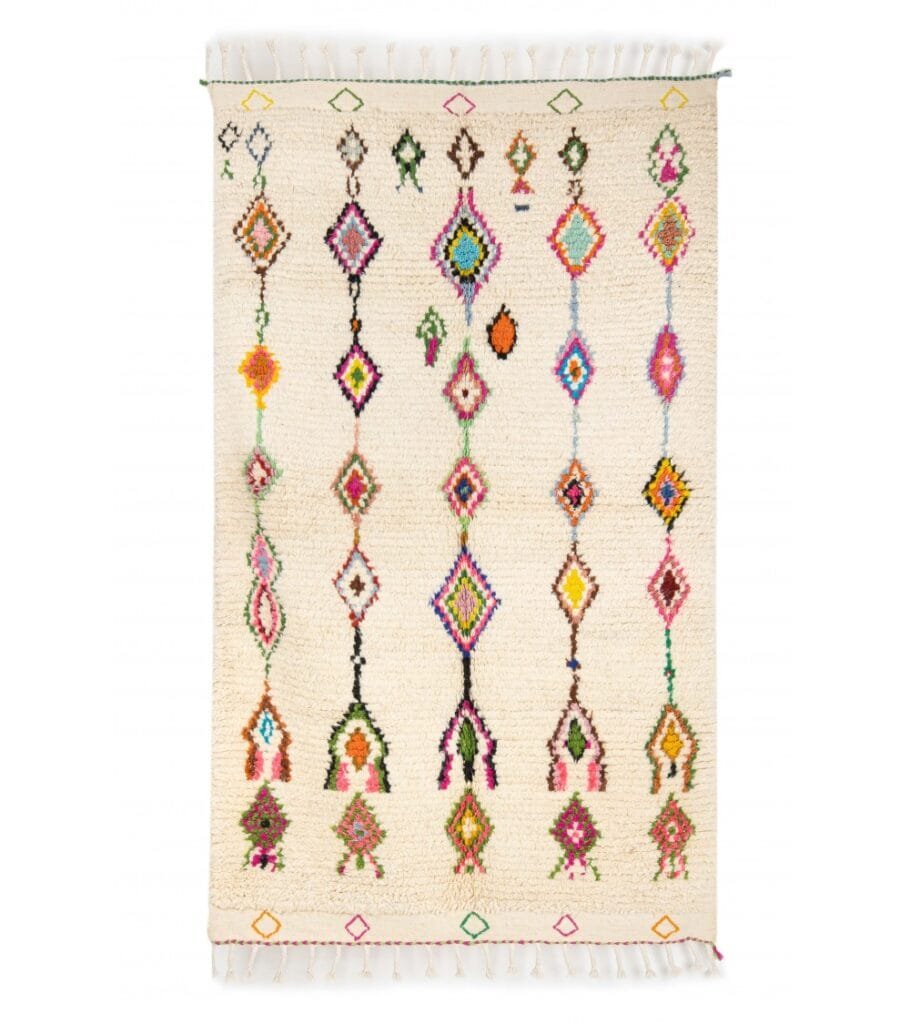
SAMPLE : AZILAL RUG
History
Azilal rugs originate from the Azilal region of the Atlas Mountains in Morocco, where they have been crafted by Berber women for generations. Traditionally, these rugs were made for personal use within the Berber community, serving as practical floor coverings, bedding, and even as ceremonial pieces for special occasions. Today, Azilal rugs have gained international recognition for their vibrant colors, expressive patterns, and cultural significance.
Signification
Azilal rugs hold deep cultural and symbolic meaning for the Berber tribes of Morocco. Each rug is a reflection of the weaver’s personal experiences, beliefs, and worldview, with patterns and motifs that convey stories of nature, spirituality, and everyday life. Through the art of rug weaving, Berber women express their identity, creativity, and connection to their ancestral heritage.
Symbols & Colors Used
Azilal rugs are known for their bold colors, expressive patterns, and playful symbols that capture the essence of Berber culture. Common motifs include diamonds, chevrons, and abstract shapes, each carrying its own symbolic significance. The colors used in Azilal rugs are often vibrant and varied, ranging from rich blues and greens to fiery reds and oranges, reflecting the natural beauty of the Moroccan landscape and the vibrant spirit of the Berber people.
Raw Materials
Azilal rugs are crafted from locally sourced wool, which is sheared from the sheep that graze the fertile valleys of the Atlas Mountains. The wool is hand-spun into yarn using traditional techniques, resulting in fibers that are soft, durable, and resilient. In addition to wool, some Azilal rugs may incorporate other natural materials such as cotton or recycled textiles, adding texture and depth to the finished piece.
How to Recognize the Type of Rug
Authentic Azilal rugs can be identified by their vibrant colors, expressive patterns, and soft, plush pile. Look for intricate geometric designs, playful symbols, and irregularities in the weaving, as these are characteristic of handmade craftsmanship. Additionally, Azilal rugs often feature a fringe detail or unique border pattern that distinguishes them from other Moroccan rug styles.
Boucherouite Rugs: Eclectic Creations of Upcycled Textiles
Discover the eclectic beauty of Boucherouite rugs, made from recycled textiles and fabrics by Berber women artisans. These one-of-a-kind creations feature an explosion of colors and textures, adding a playful and eclectic touch to modern interiors.
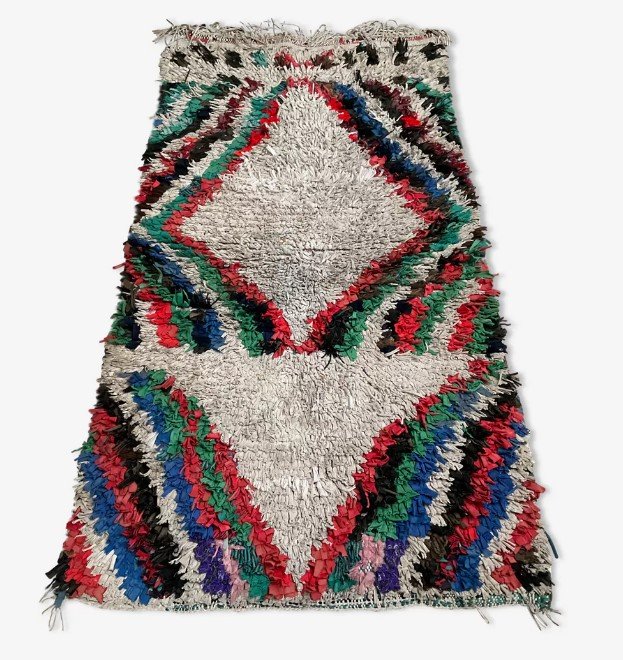
SAMPLE : BOUCHEROUITE RUG
History
Boucherouite rugs have a fascinating history that reflects the resourcefulness and creativity of the Berber women who weave them. The word “Boucherouite” translates to “torn and reused clothing” in Arabic, highlighting the rug’s origins in upcycling scraps of fabric and clothing. Historically, Boucherouite rugs emerged as a response to economic challenges faced by Berber communities, offering an affordable and sustainable alternative to traditional wool rugs.
Signification
Boucherouite rugs symbolize resilience, adaptability, and ingenuity, embodying the spirit of resourcefulness and creativity that defines Berber culture. Each rug is a unique expression of the weaver’s artistic vision, incorporating a diverse range of colors, textures, and patterns gleaned from recycled materials. Boucherouite rugs serve as vibrant tapestries of memory and tradition, preserving fragments of personal and communal history within their woven fibers.
Symbols & Colors Used
Boucherouite rugs are celebrated for their kaleidoscopic colors, bold patterns, and playful compositions, which evoke a sense of joy and spontaneity. The rugs feature an eclectic mix of motifs drawn from Berber heritage, including geometric shapes, tribal symbols, and abstract designs. Colors are chosen intuitively, reflecting the weaver’s mood, environment, and cultural influences, resulting in rugs that are as diverse and dynamic as the landscapes of Morocco.
Raw Materials
Boucherouite rugs are crafted from a diverse array of recycled materials, including cotton, wool, nylon, and synthetic fibers sourced from discarded clothing, textiles, and household fabrics. These materials are carefully sorted, shredded, and repurposed by skilled artisans, who transform them into vibrant yarns for weaving. Boucherouite rugs embrace the principles of sustainability and environmental stewardship, turning waste into works of art that celebrate the beauty of imperfection and reuse.
How to Recognize the Type of Rug
Authentic Boucherouite rugs can be identified by their vibrant colors, eclectic patterns, and diverse textures, which result from the varied materials used in their creation. Look for a patchwork-like appearance with visible seams and irregular shapes, as these are characteristic of Boucherouite rugs made from recycled fabrics. Each rug is a one-of-a-kind masterpiece, reflecting the individual style and creative vision of the artisan who crafted it.
Kilim Rugs: Timeless Elegance and Nomadic Heritage
Explore the timeless charm of Kilim rugs, meticulously handwoven by skilled artisans using flat-weave techniques. With their intricate patterns and vibrant colors, Kilim rugs bring a sense of heritage and craftsmanship to any space.
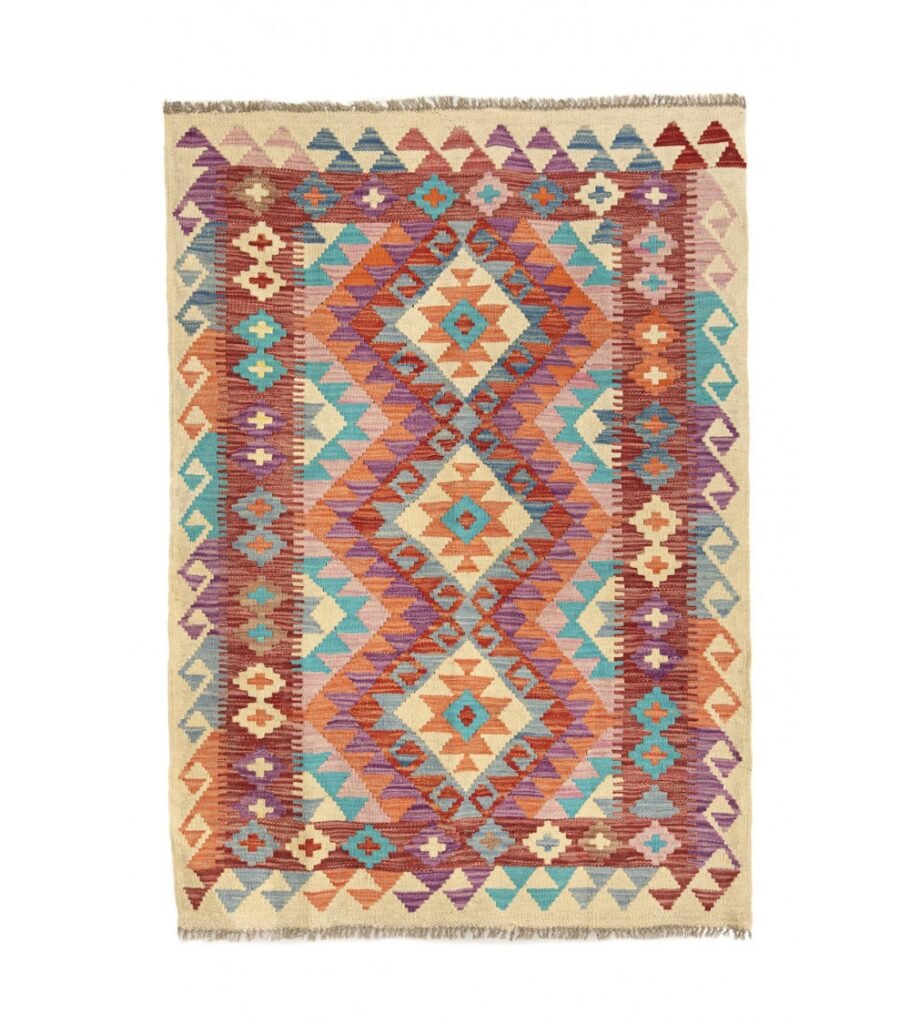
SAMPLE : KILIM RUG
History
Kilim rugs have a rich history that spans centuries and cultures, originating from the traditional weaving techniques of various nomadic tribes across the Middle East, North Africa, and Central Asia. The word “Kilim” refers to a flat-woven textile made by interweaving colored wefts and warps, creating intricate geometric patterns and designs. Historically, Kilim rugs served as essential items for nomadic tribes, providing warmth, insulation, and portable furnishings for their tents and dwellings.
Signification
Kilim rugs hold deep cultural significance for the nomadic communities that weave them, serving as valuable assets and expressions of cultural identity. Each Kilim rug tells a story of its maker’s journey, reflecting their traditions, beliefs, and experiences as they traverse landscapes and cultures. Beyond their practical function, Kilim rugs are revered as symbols of resilience, resourcefulness, and artistic craftsmanship, embodying the nomadic spirit and heritage of their creators.
Symbols & Colors Used
Kilim rugs are characterized by their bold colors, geometric patterns, and symbolic motifs, which vary depending on the region and tribal traditions of their creators. Common symbols found in Kilim rugs include diamonds, stars, medallions, and stylized animals, each carrying its own significance within the cultural context of the weaver. Colors are chosen deliberately to convey specific meanings and emotions, with vibrant hues such as red, blue, yellow, and green symbolizing vitality, protection, and spiritual harmony.
Raw Materials
Kilim rugs are traditionally woven using natural fibers such as wool, cotton, or silk, sourced from local sheep, goats, or plants. These materials are spun into yarns and dyed using natural pigments derived from plants, minerals, and insects, resulting in a rich palette of earthy tones and vibrant colors. The flat-woven technique of Kilim rugs allows for intricate patterns and designs to be created without the use of knots, resulting in lightweight, versatile textiles that are ideal for both floor coverings and decorative wall hangings.
How to Recognize the Type of Rug
Authentic Kilim rugs can be identified by their flat-woven construction, which lacks the pile found in traditional knotted rugs. Look for a tight, even weave with clear and distinct patterns, as well as vibrant colors and geometric motifs characteristic of Kilim design. Kilim rugs often feature kilim borders, which are narrow bands of decorative patterning that frame the main body of the rug. Additionally, Kilim rugs may exhibit subtle variations in color and design due to the handmade nature of their production, adding to their unique charm and character.
Rugs of BNI MRIRT: Intricate Knots and Geometric Precision
Explore the artistry of BNI MRIRT rugs, distinguished by their intricate knots and geometric precision. Handcrafted by the Berber tribes of the Middle Atlas region, these rugs feature striking diamond and zigzag patterns in vibrant hues of red, blue, and yellow.
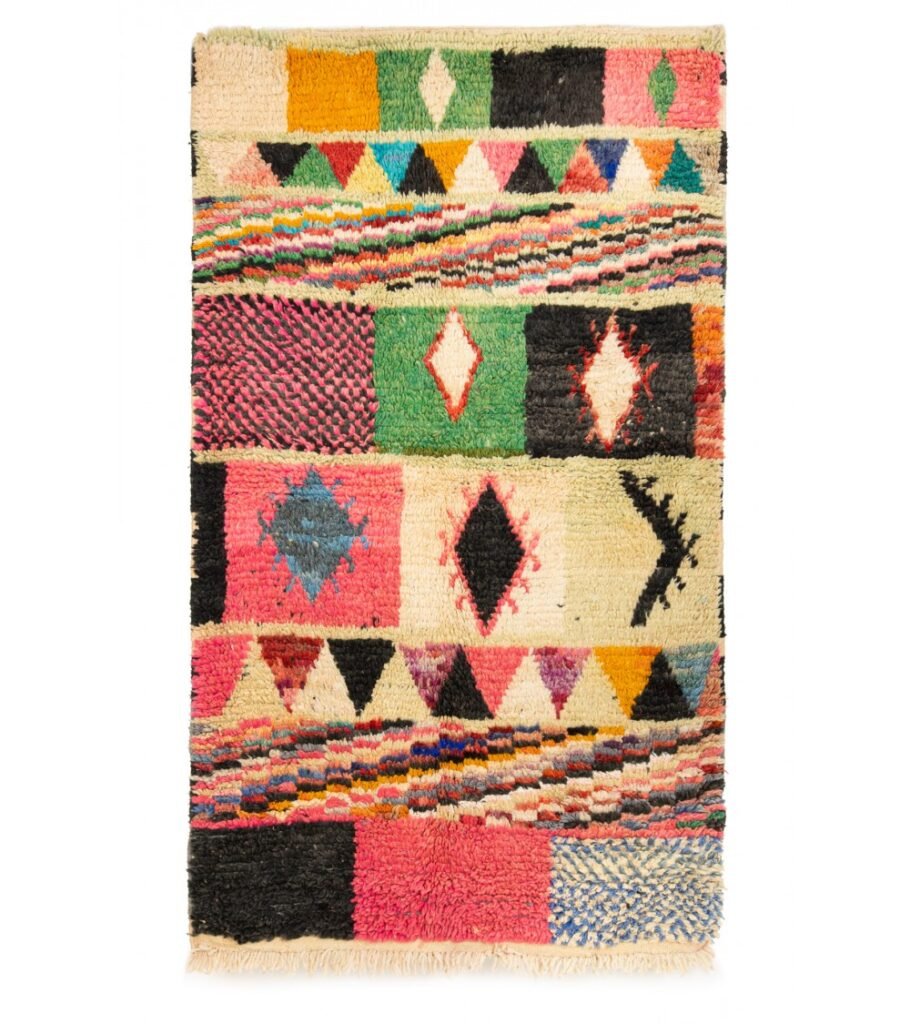
SAMPLE : BNI MRIRT RUG
History
The rugs of Bni Mrirt have a long-standing tradition rooted in the rich cultural heritage of the Beni Ourain tribe in Morocco. Located in the Middle Atlas Mountains, the region of Bni Mrirt is renowned for its distinctive style of rug weaving, which has been passed down through generations of Berber women. Historically, these rugs served as essential household items, providing warmth and comfort to families living in the rugged mountain terrain.
Signification
Rugs from Bni Mrirt hold deep cultural significance for the Berber people, representing tradition, heritage, and community identity. Each rug is a testament to the skill and artistry of the weaver, who imbues it with symbols, motifs, and patterns that reflect Berber folklore, spirituality, and daily life. Beyond their practical function, Bni Mrirt rugs are revered as valuable heirlooms and symbols of cultural pride, passed down from one generation to the next.
Symbols & Colors Used
The rugs of Bni Mrirt feature a distinctive aesthetic characterized by geometric patterns, tribal symbols, and earthy colors. These designs are steeped in symbolism, with motifs representing elements of nature, fertility, protection, and spirituality. Common symbols found in Bni Mrirt rugs include diamonds, chevrons, and lozenges, each carrying its own meaning within Berber culture. The colors used in these rugs are typically natural hues such as ivory, black, brown, and taupe, reflecting the rugged beauty of the Moroccan landscape.
Raw Materials
Rugs from Bni Mrirt are handwoven using high-quality wool sourced from local sheep herds that graze in the Atlas Mountains. The wool is known for its softness, durability, and insulating properties, making it ideal for crafting cozy, resilient rugs. Skilled artisans hand-spin the wool into yarns, which are then dyed using natural pigments derived from plants, minerals, and insects. This traditional dyeing process results in rich, earthy tones that complement the rustic charm of Bni Mrirt rugs.
How to Recognize the Type of Rug
Authentic rugs from Bni Mrirt can be identified by their distinctive patterns, colors, and textures, which set them apart from other Moroccan rug styles. Look for geometric motifs such as diamonds, chevrons, and zigzags arranged in symmetrical or asymmetrical compositions. Pay attention to the quality of the wool and the density of the weave, as well as any irregularities or variations that indicate handmade craftsmanship. Each Bni Mrirt rug is a unique work of art, reflecting the skill, creativity, and cultural heritage of the artisans who create them.
Taznakht Rugs: Timeless Elegance with Berber Tradition
Taznakht rugs are a treasured tradition originating from the Taznakht region in southern Morocco. Known for their exquisite craftsmanship, vibrant colors, and rich symbolism, these handwoven rugs are a testament to the cultural heritage and artistic skill of the Berber people. Each Taznakht rug tells a story of tradition, spirituality, and connection to the natural world, making them cherished pieces of art that embody the spirit of Berber culture and pride.
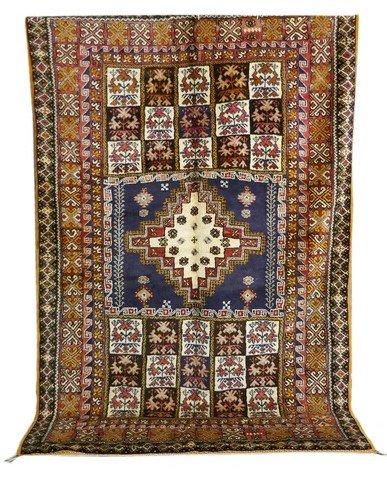
SAMPLE : TAZNAKHT RUG
History
Taznakht rugs originate from the Taznakht region in southern Morocco, where they have been handwoven by Berber women for generations. These rugs are renowned for their exquisite craftsmanship, intricate designs, and rich symbolism, reflecting the cultural heritage and artistic traditions of the Berber people. Historically, Taznakht rugs served as integral parts of Berber households, offering warmth, comfort, and beauty to their interiors, while also serving as valuable assets passed down through families.
Signification
Taznakht rugs hold deep cultural significance as symbols of Berber identity, heritage, and craftsmanship. Each rug is a masterpiece of artistry and skill, representing the collective wisdom, creativity, and resilience of the Berber community. Through their intricate patterns, vibrant colors, and symbolic motifs, Taznakht rugs tell stories of tradition, spirituality, and connection to the natural world, serving as tangible expressions of Berber culture and pride.
Symbols & Colors Used
Taznakht rugs feature a diverse array of symbols, motifs, and colors that hold special meanings within Berber culture. Common symbols found in Taznakht rugs include geometric shapes, floral patterns, and symbolic representations of animals, each carrying its own significance and symbolism. The colors used in Taznakht rugs are often bold and vibrant, with hues of red, blue, green, and yellow dominating the palette, reflecting the natural landscapes and cultural traditions of the region.
Raw Materials
Taznakht rugs are traditionally handwoven using locally sourced wool from the sheep herds that roam the Atlas Mountains and surrounding areas. The wool is prized for its softness, durability, and natural resilience, making it ideal for crafting high-quality rugs that withstand the test of time. Skilled artisans spin the wool into yarns using traditional techniques, which are then dyed using natural pigments derived from plants, minerals, and insects, resulting in a rich spectrum of colors that enhance the beauty of Taznakht rugs.
How to Recognize the Type of Rug
Authentic Taznakht rugs can be identified by their distinctive patterns, colors, and textures, which reflect the unique artistic traditions and cultural heritage of the region. Look for intricate geometric motifs, floral designs, and symbolic elements that are characteristic of Taznakht rug weaving. Pay attention to the quality of the wool and the precision of the weaving, as well as any imperfections or irregularities that signify the handmade nature of the rug. Each Taznakht rug is a testament to the skill, creativity, and cultural legacy of the Berber artisans who create them.
Other Famous Moroccan Rugs:
In addition to the aforementioned rugs, Morocco boasts a diverse array of other famous rug styles, each with its own unique characteristics and cultural significance. Some of these include:
- Boujad Rugs: Hailing from the Boujad region of Morocco, these rugs are prized for their bold colors, asymmetrical designs, and expressive motifs. Boujad rugs often feature intricate patterns inspired by tribal traditions and are known for their vibrant, eye-catching appeal.
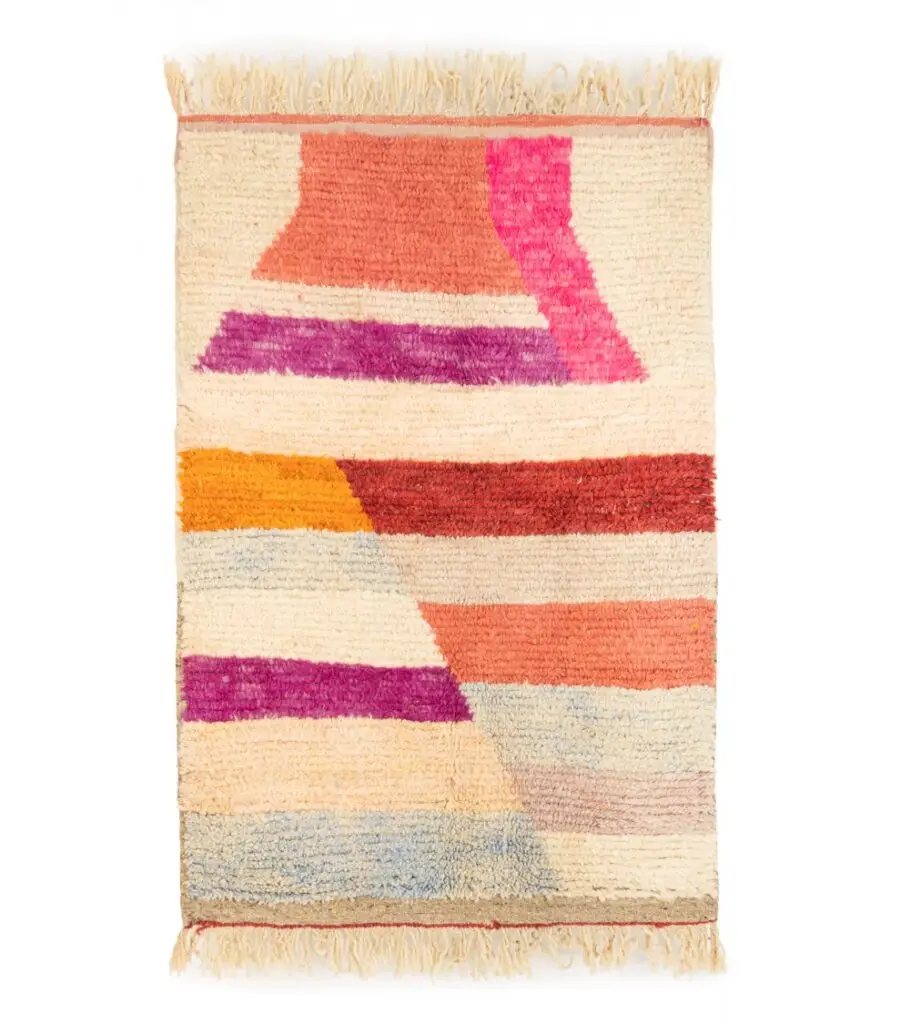
SAMPLE : BOUJAAD RUG
- Zemmour Rugs: Zemmour rugs come from the Zemmour tribe in central Morocco and are characterized by their geometric patterns, deep red hues, and intricate weaving techniques. These rugs often feature traditional Berber motifs such as diamonds, chevrons, and zigzags, symbolizing protection, fertility, and prosperity.
Conclusion
Moroccan rugs are not just floor coverings; they are woven stories that encapsulate the rich cultural heritage and artistic traditions of the Berber people. From the rugged Atlas Mountains to the vibrant markets of Marrakech, each rug carries with it a piece of Morocco’s history and soul. Whether adorning the floors of homes around the world or displayed as works of art, Moroccan rugs continue to captivate and inspire with their beauty, symbolism, and timeless allure.
Facts about Moroccan Rugs
- Moroccan rugs have been woven by Berber women for centuries using traditional techniques passed down through generations.
- The designs and patterns found in Moroccan rugs often reflect the natural landscapes, cultural traditions, and spiritual beliefs of the region.
- Moroccan rugs are not only functional but also serve as valuable cultural artifacts and symbols of Berber identity and heritage.
FAQ about Moroccan Rugs
- What materials are Moroccan rugs made from? Moroccan rugs are typically made from natural materials such as wool, cotton, and occasionally silk. Wool is the most common material used, prized for its durability, softness, and insulating properties.
- How do I clean and maintain a Moroccan rug? To clean a Moroccan rug, gently vacuum it on a low setting to remove dust and debris. For stains, spot clean with a mild detergent and water, taking care not to soak the rug. Avoid harsh chemicals and excessive scrubbing, as these can damage the fibers. It’s also recommended to rotate the rug periodically to ensure even wear.
- Are Moroccan rugs suitable for high-traffic areas? Yes, many Moroccan rugs are durable enough to withstand high-traffic areas in the home. However, it’s essential to choose a rug with a tight weave and durable materials for these spaces to ensure longevity.
- What do the symbols and patterns on Moroccan rugs mean? The symbols and patterns on Moroccan rugs often carry cultural and spiritual significance, with each design telling a unique story or conveying specific meanings. Common motifs include geometric shapes, tribal symbols, and representations of nature, with interpretations varying across different regions and tribes.
- Where can I buy authentic Moroccan rugs? Authentic Moroccan rugs can be found in local souks (markets) and artisan cooperatives across Morocco. Additionally, many online retailers offer a wide selection of Moroccan rugs, allowing buyers from around the world to purchase these beautiful and culturally significant pieces.

